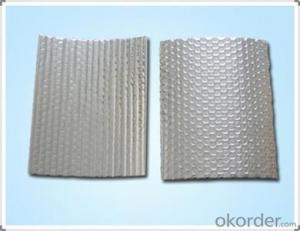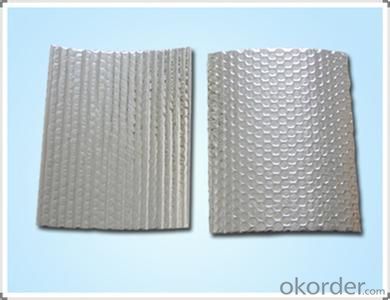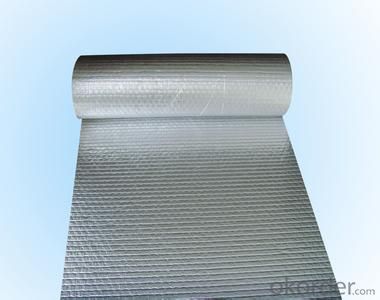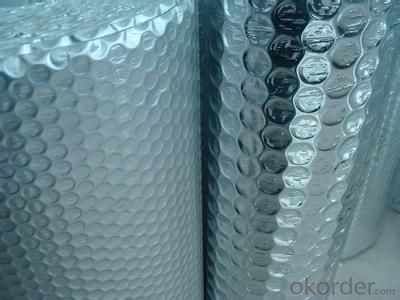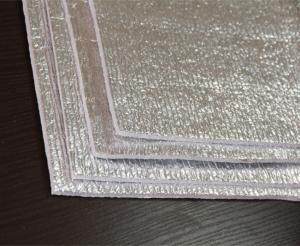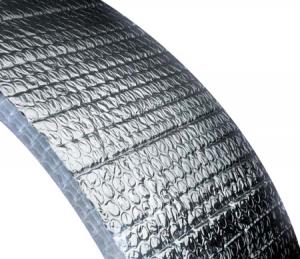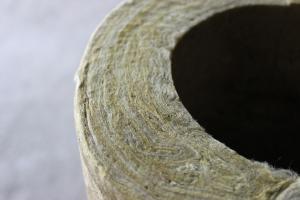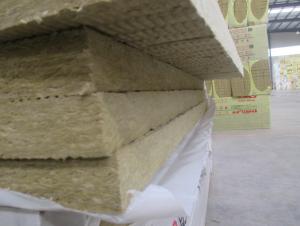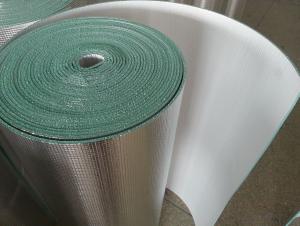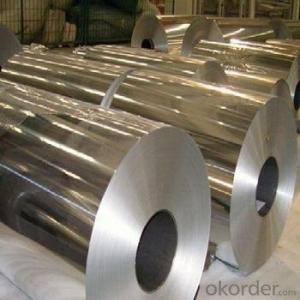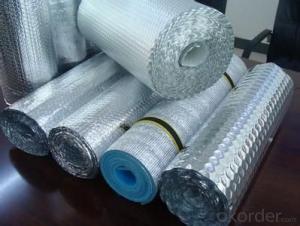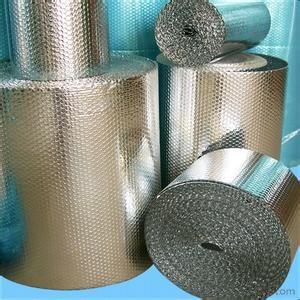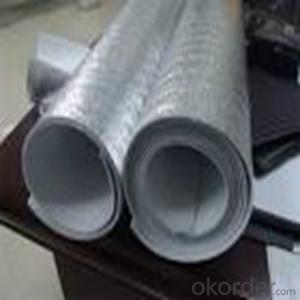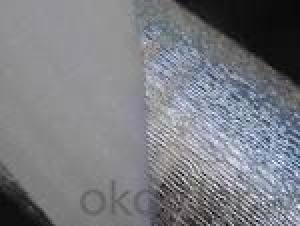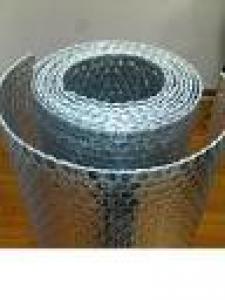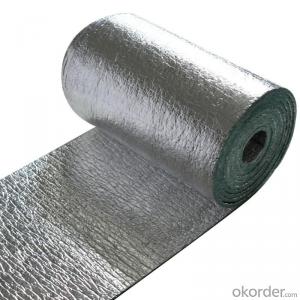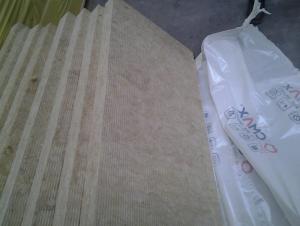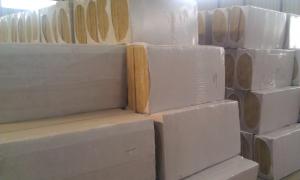Buy Roofing Insulation - Aluminum Foil Coated Bubble Insulation Type 2
- Loading Port:
- Shanghai
- Payment Terms:
- TT OR LC
- Min Order Qty:
- 10000 m²
- Supply Capability:
- 100000 m²/month
OKorder Service Pledge
OKorder Financial Service
You Might Also Like
Bubble Insulation Benefits:
Reflects 96% of radiant heat
Non-toxic / Non-carcinogenic
Does not require protective clothing or respirators to install
Durable and lightweight
Does not compress, collapse or disintegrate
Vapor and radon retarder
Easy to cut and install
Permanent and maintenance-free
Does not provide a growth medium or nutritive value for fungus, insects, or rodents
Does not support the growth of mold or mildew
Not affected by moisture or humidity
Lowers heating and cooling costs year round
Bubble Foil Application:
Metal & Steel Buildings
Homes
Roof Underlayments
Cathedral Ceilings
Crawl Spaces
Hot Water Heaters
Basement Walls
Floors
Garage Doors
Concrete slabs
Driveway snow melts
Pole barns
Post frame buildings
Poultry barns
Animal kennels
Temperature sensitive storage areas
Air Bubble Foil Insulation Tech Data:
Material Structure: AL/Bubble/AL | ||
Bubble Size:D10mm*H 4mm(10*2.5/10*4/10*6/20*7/25*10)choose the bubble size | ||
Bubble Weight:0.13kg/m2 ( can be customized ) | ||
Roll Width:1.2m (lenth can be customized) | ||
PROPERTIES | TEST DATA | UNIT |
Thickness | 3.5-4 | mm |
Weight | 250 | g/m2 |
Emissivity | 0.03-0.04 | COEF |
Thermal conductivity | 0.034 | w/m0 |
Apparent Density | 85 | kg/m3 |
Reflectivity | 95-96 | % |
Water Vapour Transmission | 0.013 | g/m2kpa |
Corrosion | doesn't generate | |
Tensile Strength(MD) | 16.98 | Mpa |
Tensile Strength(TD) | 16.5 | Mpa |
- Q: No insulation was installed under roof of my 2 story home. Im not rich but looking for info on installing about 450 ft. up there.
- Based on the geography you are put up insulation rates would differ, I would suggest initially you just call Insulation contractors who offer free home energy audits and ask them to give their estimate , based on the rates you choose one which suits your budget. Usually type of insulation you choose determines your rate, so do a little homework on it
- Q: I live in central florida. I plan on installing R-30 insulation to the floor of my attic. How effective is it to install reflective insulation to the attic on the roof side? Is it worth the price?
- No dont add to the roof. The under side of the roof needs air flow and you will trap moisture, causing mold and rot. Make sure you have plenty of vents under your eaves and take your extra money and buy a solar powered attic fan (or 2 ) Mark
- Q: Does snow on the roof help or hurt my heating bill?
- I would think that the snow on your roof actually helps to insulate your house more. Think about dog sled teams in the far north the dogs dig themselves under the snow to stay warm at night. Also I have taken winter survival trips while I was in Canada and was taught that snow acts as an insulator. I think it helps.
- Q: So I'm renovating an old farmhouse with a metal roof and there is no insulation in the attic. I was up in the attic checking for leaks since we just got some freezing rain and it is currently melting I thought now was the perfect time to check. I found no leaks but I did notice the roof was sweating with noticeable beads of water in many places and many of the 2x4's that act as the frame were damp, although none were rotted (I found that odd as the house is approx. 140 years old and those are the original 2x4's. I could tell that the attic does have vents so I guess it dries out before rotting or mold occurs.. but makes me wonder if I put down some roll-in faced R-30 Owens Corning Insulation and then add a plywood floor over top if everything will be fine.. or not so fine..
- I own an 80 year old house -- a home originally built as temporary housing for people working in the airplane industry during the war, and for returning soldiers. Temporary housing that is better structurally than many new homes. In fact, the original design and work was brilliant in its simplicity and precision, and I have found that the problems with my house are the result of work done later on -- additions and fix ups that screwed with the original integrity. One thing I have learned RE old houses is it is often best to leave well enough alone. This does not mean one should not address definite problem, or add certain features, but it does mean one has to think things through and do a great deal of research before acting. As you say, the structure of the roof is the original, so all the folks who had the house before you must have been doing something right. If I were you, I would ask around my community, do some internet searches, and find someone in your area who is an expert on dealing with historical structures of the area. This person will not necessarily be a master craftsman with a PhD in history and another in architecture. It may actually be a skilled handyman or carpenter who is continuing the old family business. He also probably lives in an old farm house, or knows plenty of folks who do. THAT is the guy you want to consult.
- Q: im thinking of putting rolled felt paper under my metal roofing would that work instead of the reflective insulation instead?
- I installed a metal roof 5 years ago. I stripped the roof down to the plywood and put down 30# felt. This was what the manufacturer recommended. The felt is not for insulation though. The company was Metal Sales out of PA. They are glad to give advise.
- Q: Re-roof + gutters + insulationHi. My name is Sean and I live in Adelaide. I want to get rid of my asbestos roof and replace it with a Colorbond roof and new gutters and also R3 ceiling insulation. I've had 1 quote so far for $17,000 total costs, and 1 quote for roof removal only which was $3,300. Does anyone know if I can get a cheaper quote but still get a good job done please?Roof area: 160m2 approx.Gutters: 25 linear metres approx.Capping: 52 linear metres approx.Cheers.
- I am a roof plumber in melbourne I think this is a reasonable price. Materials will cost approx 8000-10000 grand 3300 for asbestos removal and the rest for labour. The best advice is plenty of quotes and keep them to their quotes. If you can get a roll of metal direct from bluescope you can get a company like apex roofing to roll it for you but it is alot of mucking around to save a little bit
- Q: I know when you inhale the insulation from the roof irritates the throat but what can you do to clear it from your throat after inhaling it?
- it's not your throat you should be worried about. it's your lungs. wear a respirator....or at the very least, a dust mask. you only live once so make it last.
- Q: I added a screened room to my mobile home. I also have vinyl windows. in the summer the sun beats down on the home almost all day Someone told me I could have insulation installed in the roof panels, and that i may even be able to do it myself. Right now it's impossible to enjoy my patio between 1-5pm because it so hot you can't breath. I'm in the Pasco, FL area - 34667Appreciate any help you can give
- I agree with RustyNail that the panels are thin and not meant to support that kind of weight. But, I think a wall anchor that spreads the weight inside the foam would work if that's the only place to attach. I'm imagining that there's no wall available since these usually are just supported at the ends. If so, then my first suggestion would be no curtains at all. My second would be to find a long wall anchor. With 6" of foam, I would think you could do a 4" long anchor and get pretty good support. Rusty may disagree.
- Q: I am thinking about getting cavity wall and roof insulation at the moment.But since summer is approaching, I fear that getting the insulation will mean that the house will be very hot at night. (During day time the house will accumulate heat from the sun, and the heat cannot escape).I also fear that the ventilation will be bad and the air in the house will not be as fresh.Any advice please?
- Insulation helps both in heating in the winter and with cooling in the summer!
- Q: What are the roof insulation materials?
- Is made from volatile polystyrene beads containing volatile liquid foaming agent, and a white solid having a fine closed-cell structure which is thermoformed in a mold after being preheated by heating
Send your message to us
Buy Roofing Insulation - Aluminum Foil Coated Bubble Insulation Type 2
- Loading Port:
- Shanghai
- Payment Terms:
- TT OR LC
- Min Order Qty:
- 10000 m²
- Supply Capability:
- 100000 m²/month
OKorder Service Pledge
OKorder Financial Service
Similar products
Hot products
Hot Searches
Related keywords
